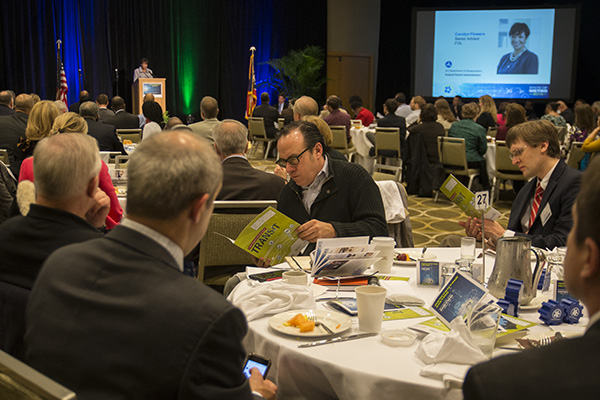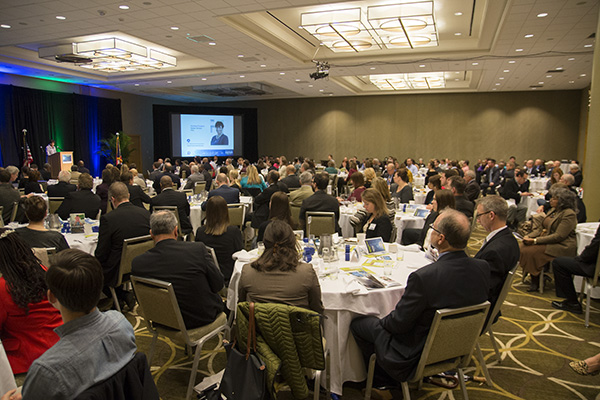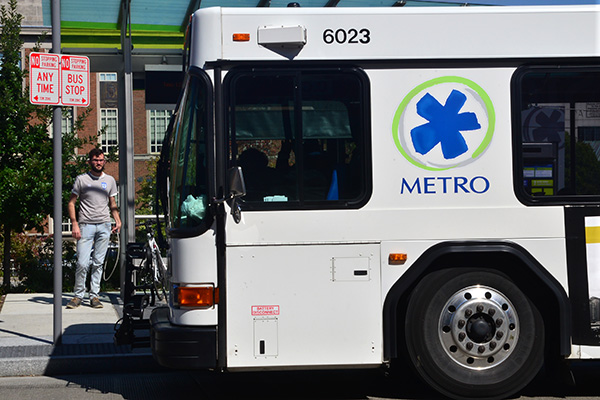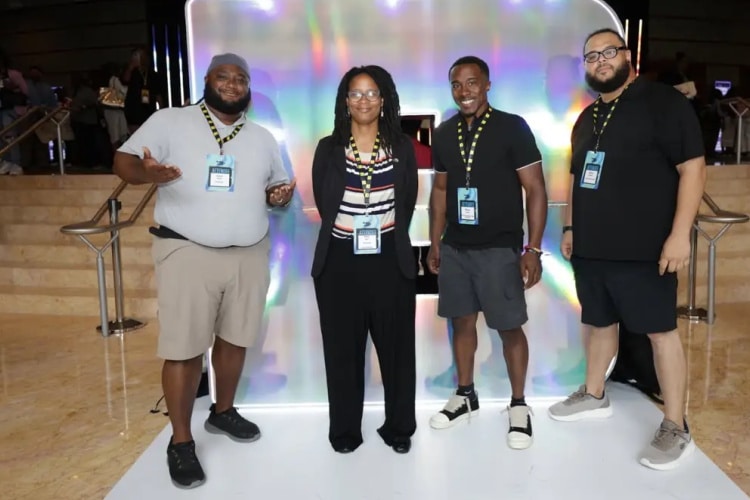Soapdish: Good public transit makes Cincinnati competitive, not trendy
Walkability, bikeability, ride and bike share and modern transit such as streetcars are the "new normal," and Cincinnati needs to step it up. Our goal is not to be trendy, it's to be competitive.
Last Friday, your always adventurous and intrepid Soapdish columnist ventured deep into the Westin Hotel to partake in a ballroom breakfast celebrating “The State of Metro 2015.” That’s right, an opportunity to take stock in our local transit operations — its highlights, its milestones and its inexorable path forward into the future.
Now, to be honest, transit breakfasts aren’t something I make a habit of attending, but this one offered a glimpse into a rapidly changing local transit landscape.
The streetcar is already running successful (and highly popular on social media) test loops around town. Something called the Metro Futures Task Force has been conducting a number of different “listening sessions” and surveys across the region soliciting feedback on how the community wants Metro to go forward. And a recent “regional indicators report” commissioned by Cincinnati USA Chamber’s Agenda 360, Northern Kentucky’s Skyward organization and the Urban Land Institute released findings on our transit competitiveness with peer cities and, in particular, where we lag behind.
The breakfast itself was a curious mix of pomp and circumstance, pseudo call-and-response sermonizing, transit wonk lecture and police color guard pageantry. It was also, I might add, surprisingly scant on elected officials, with Yvette Simpson being the lone Cincinnati Councilmember in attendance. Mayor John Cranley was not in the ballroom.
For an organization that prides itself on being “on time,” the event also ran unnecessarily long by about 30 minutes. The irony wasn’t lost on me.
What became clear almost immediately at the event, ably emceed by Enquirer sports scribe Paul Daugherty, was that the state of the Cincinnati Bengals was “strong” (at least as of last week; today not so much). Speakers and hosts continually returned to the Bengals for comfortable laughs and jibes — speaker Valarie McCall, director of the American Public Transit Administration, is a Cleveland native and so the Browns jokes practically wrote themselves.
Both Jason Dunn, chair of the Southwest Ohio Regional Transit Authority (SORTA), and Metro CEO and General Manager Dwight Ferrell touted Metro’s accomplishments over the past year and what we need to do to stay competitive with our peer cities. Some of these “accomplishments” were highlighted in the printed program: hired new CEO; realigned executive staff; retained new federal lobbyists; convened task force; balanced budget without fare increase or service reductions; increased bus advertising to generate additional revenue. Not exactly ground-breaking stuff.
But there were other breakthroughs worth celebrating, such as developing real-time information to smart phone apps (Bus Detective and Transit); bus tracker real-time information on the Metro website; and preparing for the Cincinnati Streetcar launch — which surprisingly was mentioned infrequently or, in the case of Ferrell’s remarks, not at all.
Dunn and Ferrell acknowledged that public transit helps attract more people, jobs and economic development, particularly with that key Millennial demographic. But their strategies seemed more of the “say smartphone, Milllennials and apps a lot” variety than re-thinking how we remain competitive with our peer cities when it comes to transit.
Nowhere is this re-thinking more critical than in the context of the aforementioned “regional indicators report,” which found that Cincinnati ranks dead last among its peer cities — Austin, Charlotte, Cleveland, Columbus, Denver, Indianapolis, Louisville, Minneapolis, Pittsburgh, Raleigh and St. Louis — in jobs reachable by public transit, clocking in at an embarrassing 58.9 percent. By comparison, 86.6 percent of jobs in Denver are reachable by transit.
Minneapolis, Denver and Pittsburgh have spent the most money on public transit in recent years among these peer cities, and unsurprisingly they have the highest ridership rates.
The gross differences in transit spending, according to the report, are partly explained by funding sources. Pittsburgh and Minneapolis have more than 50 percent of their operating costs covered by state subsidy. In our region, however, subsidies are historically low, with our local transit systems getting about 0.2 percent of their operating funds from the state.
It’s been well documented that Millennials nationwide are driving less and using other transit options more, eschewing the reflexive car purchase as a barometer of adulthood. The report suggests that “the fact that many Millennials have not returned to cars (post “Great Recession”) may indicate that we are experiencing a ‘new normal.’”
Cincinnati’s Millennials apparently are bucking that trend and still collectively motoring along at a high rate. Between 2000 and 2013, all peer regions save Cincinnati saw a drop in the percentage of Millennials commuting by car — though the report notes that it’s difficult “to know whether Cincinnati’s patterns are the result of choice or a lack of options.”
This statistic and accompanying comment sparked a reflection (as I silently doodled in my notebook at the table) about the hard and very real costs of living in a transit-deficient environment. There are more cars on the road, more stress on the infrastructure and more pollution, to be sure. That’s a given.
But there are also the questions of “Where do you put all those cars? Where do you park them?”
A byproduct of all this driving is a thriving parking garage construction industry, and Cincinnati is no slouch in this regard. Cincinnati currently has a plethora of major parking structures built in the past decade, including the indescribably enormous 8,000-space Banks garage that at least has the dual purpose of raising the developments out of the flood plain.
These garages are sold as being critical to corresponding downtown development — for example, the 1,000-car garage for 550 employees at the 84.51 building (nee Dunnhumby) or the 500-car garage being built at the Eighth and Sycamore apartment/hotel development. But why does a development of 131 units need a garage for 500 cars, particularly when it overlooks an acre of intractable surface parking lot blight across the street, a pockmarked, life-sucking Dead Sea of asphalt in the middle of downtown? Perhaps the answer lies in our transit-deficient/car-loving society.
Yet the times, as they say, are a’changing. The streetcar is happening, bike ridership is on the rise and people are clamoring to live in the highly walkable urban core. The curve will still lag behind such trends, though, and as a result garages keep being constructed at alarming rates.
Let’s just do a quickie-style, back-of-the-handkerchief tally on recent garage construction. For these ballpark estimates, we’ll put the costs of above ground garage construction at $18,000 per space and underground at $30,000 per space, which are generally accepted baselines in the industry.
By that calculation, we have the yet-to-be-constructed Eighth and Sycamore and Ziegler Park garages clocking in at $9 million and $12 million, respectively. The 1,000-space behemoth at 84.51 and Fountain Square’s 635 subterranean spaces just a block away give you another $43 million and change. Throw in Over-the-Rhine’s Mercer, Gateway and Washington Park garages, and you’re looking at another $34,620,370 or so.
My noodling provides a grand total approaching $100 million in the past decade or so, give or take a few years (and a lot of dollars).
And that’s just in the urban core. I’m not even talking about the parking garage highrises dotting the Pill Hill landscape just a scant mile or two away from downtown, all built in the past decade or less.
While I realize these are overly simplistic, apples/oranges kinds of comparisons, the fact remains that our public transit system is a key factor in Cincinnati’s ability to attract new residents — especially the coveted Millennials — away from peer cities. We’re losing that race badly, as the report indicated.
As a corollary, we continue to build parking at an alarming rate to compensate in part for our transit deficiencies. Think about where the streetcar could go with an additional $100 million (hint: up to UC for starters).
Nobody is focused on pothole filling, expressway widening, road resurfacing and parking garage construction when they research the next up-and-coming city. All modern urban centers are expected to excel at “basic services” — those are the lowest common denominators.
Walkability, bikeability, ride and bike share and modern transit such as streetcars are the “new normal,” and Cincinnati needs to step it up, backslapping breakfasts notwithstanding. Our goal is not to be trendy, it’s to be competitive.


















